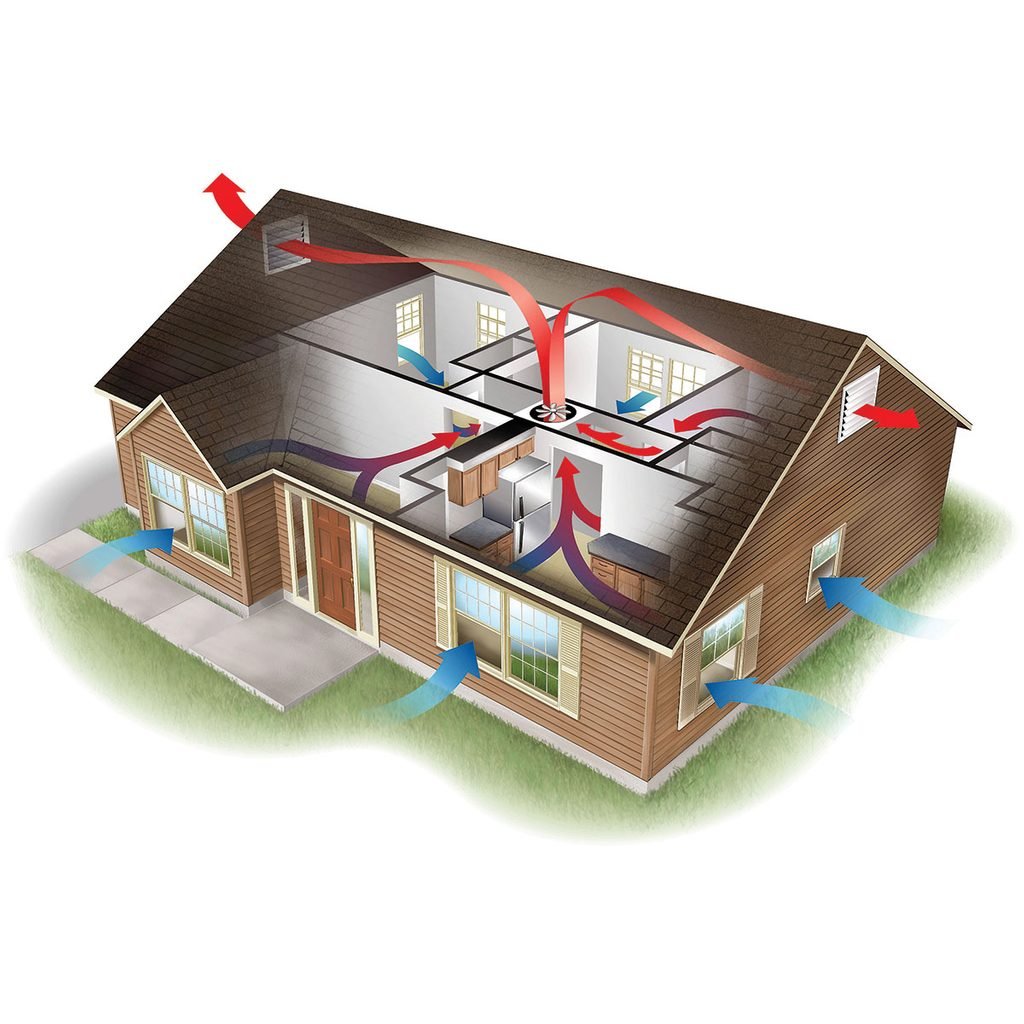How to Choose the Best Whole House Fan for Your Home
Updated: Oct. 10, 2023

What is a whole house fan? Not only can these helpful ventilation systems help keep you cool, but they also help save on energy costs.
Whole house fans will keep you and your home cool at a fraction of the cost of air conditioning. Here, we’ll walk you through the pros and cons and help you choose the best option for your home.
On This Page
What Is a Whole House Fan?
A whole-house fan is a large electric fan, usually centrally located within a home or other building, that circulates air through the entire place. It pulls in fresh air from open windows and doors and pushes hot air out and into an attic, where it can then escape through attic vents.
Whole House Fans vs. Attic Fans: What’s the Difference?
An attic fan is made specifically to ventilate an attic, pulling out hot, stale air so that heat and humidity don’t build up in your attic. An attic fan helps prevent problems like mold and mildew from the space and even helps extend the life of your roof by preventing problems like ice dams in the winter and excessive heat buildup in the summer.
How Does a Whole House Fan Work?
The basic concept is simple: An attic-mounted fan pushes hot air out through attic vents and draws cooler, outside air in through open doors and windows. This rapid air exchange—large fans can purge a house of hot air in two to three minutes—not only removes built-up heat but also creates a pleasant breeze.
A whole house fan can turn over the air in a home up as much as six times an hour, depending on the size of the house.
When you use a whole-house fan, it’s important to open doors and windows. Otherwise the fan may cause gas-burning appliances, such as your furnace or water heater, to backdraft exhaust fumes and carbon monoxide into your home. Whole house fans are not allowed in all areas. You should check your local building codes before buying one.
How whole house fans keep a home cool and save on energy costs
Depending on the severity of your summers, a fan can work as an efficient pre-chiller before you switch on your air conditioner, or even as your sole source of cooling. Using only a tenth as much power as your air conditioner, a fan bringing in cooler night and/or morning air can lower inside temperatures by 5 degrees or more in just a few minutes and help you save on energy costs.
For homeowners living in dry climates with wide day/night temperature swings, you may be able to do without the air conditioner by simply switching the fan on during cool hours and then turning off the fan and shutting the house during the hottest times of the day.
Whole-house fans aren’t perfect. They can’t cool inside temps lower than outside temps, nor can they dehumidify. If you live in a humid region, you’ll still need to lean on your air conditioner in the dog days of summer. And while most folks may prefer fresh outside air, if you suffer from allergies, realize that fans draw in outdoor pollen and dust.
How to Choose a Whole House Fan
A local HVAC installer can help you find the fan that best fits your home and climate. Keep in mind that size isn’t everything. Larger fans are great for moving air quickly, but when you weigh the increased size against installation requirements, insulation, appearance, noise and cost, you may opt for a smaller fan. (Depending on your needs and floor plan, several smaller fans may provide better airflow.)
Attic ventilation is almost as important as the fan. A fan won’t work if the hot air doesn’t have an easy way out; without adequate ventilation the fan may force hot air down on you! Fans require 1 sq. ft. of net free vent area per 750 cfm. If you don’t want to install additional venting, it may make sense to stick with a smaller fan.
These days, there are several different types of fans to choose from. In addition to the large traditional models, manufacturers have come up with types that are easier to install and better insulated.
Before you buy, contact your utility company to see if you’re eligible for an energy rebate. You may also be able to reclaim a portion of the cost as an energy tax credit on your income taxes.
Types of Whole House Fans
Standard fan
Because they’re the most affordable and widely available, large-diameter fans are still a good solution for homeowners living in warmer regions. These fans cost less up front, but installation may be more difficult. Moving a joist in order to frame out a box for the fan, or installing additional attic venting might wind up costing more than the fan itself. Another disadvantage is that during the winter, the vented opening works like an open window, giving warm moist air an easy path out and into your attic. To prevent heat loss, you’ll need to build an insulated box to cover your fan during the off-season.
Pros
- Affordable
- Larger, more powerful
Cons
- Installation can be more difficult
- Heat loss in the winter without adding insulation
Insulated-door fan
If you live in an area with frequent cold snaps, you’ll want a fan that holds in the heat when it’s not in use. Door fans come with insulated (R-22 or R-38) panels that open every time you turn the fans on. This feature not only helps during winter months but also keeps heat out during the summer when you’re running your AC.
These models don’t move as much air as standard fans, but they tend to run quieter, so they can be run all night. Like standard fans, these units are usually installed in a hallway, but some smaller models are specially designed to fit in between or around existing trusses or joists to make installation easier.
Pros
- Insulated panels add to efficiency
- Quieter than standard fans
Cons
- Don’t move as much air as standard fans
- More expensive
Inline fan
Fan/insulated duct units don’t move as much air as standard fans, but by investing in one fan per bedroom, you can provide a breeze effect in the room(s) you most want to cool. The small intake port is not only less obtrusive than the large louvered panels needed with other fans but also easier to install. (A flexible duct connects the intake port to the fan.) Like insulated door fans, inline fans have damper doors within them that prevent warm air from leaking out in winter.
Pros
- Perfect for single rooms
- Easy to install
- Damper doors
Cons
- Only works for individual rooms and smaller spaces
- Not as powerful
